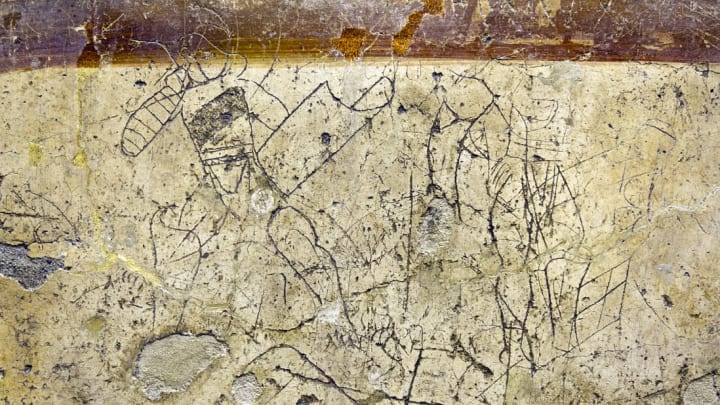Graffiti from centuries and even millennia ago can reveal the grievances, passions, games, and ordinary business dealings of regular people from the long-lost past. Pompeii might be the most famous spot to find such scrawls, but it’s not the only place where bygone messages have been found. Here are seven examples of graffiti from the ancient world.
1. “I VISITED AND I DID NOT LIKE ANYTHING EXCEPT THE SARCOPHAGUS!”
A Chinese teen visiting Egypt prompted outrage when he wrote his name on the wall of the 3500-year-old Luxor Temple in 2013. But he was hardly the first traveler to commit such an offense—there’s a long tradition of leaving “I was here” graffiti while visiting Egyptian ruins. One team of researchers recently counted over 1000 inscriptions inside the tomb of pharaoh Ramesses VI in the Valley of the Kings—many of which were from Romans who visited the site 2000 years ago. Their ancient declarations include familiar complaints of disappointed tourists: “I visited and I did not like anything except the sarcophagus!” and "I cannot read the hieroglyphs!"
2.“YOU LOVE IRIS, BUT SHE DOES NOT LOVE YOU.”

Pompeii has dominated the study of ancient graffiti, and for good reason. There are many inscriptions and painted messages that survive on the walls of this Roman city in southern Italy, which was famously buried in volcanic ash in 79 CE. And these examples often offer rich insight into the lives of the city’s residents. Behold the drama of a love triangle, apparently played out on the wall of a bar (not the one above) in taunting messages between two men named Severus and Successus:
“Successus, a weaver, loves the innkeeper’s slave girl named Iris. She, however, does not love him. Still, he begs her to have pity on him. His rival wrote this. Goodbye.” (Reply by Successus) “Envious one, why do you get in the way. Submit to a handsomer man and one who is being treated very wrongly and good looking.” (Reply by Severus) “I have spoken. I have written all there is to say. You love Iris, but she does not love you.”
3. “NIKASITIMOS WAS HERE MOUNTING TIMIONA."
Declarations of love and boasts of sexual conquest are not just the domain of modern bathroom-wall graffiti. Plenty of examples of such messages can be found in the ancient world. Erotic graffiti recently identified at the Greek island of Astypalaia documents a 2500-year-old tryst between two men: “Nikasitimos was here mounting Timiona." The general secretary at the Greek Epigraphic Society, Angelos Matthaiou, told The Guardian: "Whoever wrote the erotic inscription referring to Timiona was very well trained in writing. The letters have been very skillfully inscribed on the face of the rock, evidence that it was not just philosophers, scholars and historians who were trained in the art of writing but ordinary people living on islands too."
4. A MENAGERIE OF WILD ANIMALS

Crocodiles, elephants, rhinoceroses, baboons, and dogs are among the wild animals inscribed on the blocks of a labyrinth-like complex known as the Great Enclosure of Musawwarat es-Sufra. This monument, in modern-day Sudan, was part of the Kingdom of Kush when the drawings were made more than 2000 years ago. Some of the animals also include religious iconography, such as a lion with wings and crown said to represent the deity Apedemak. Archaeologists don't know the function of many of the rooms in the complex, but some have used the graffiti to support their theories about the purposes of different sections. They've proposed interpretations ranging from animal trading stations and elephant training grounds to a holding pen for prey that could be “hunted” by royals who needed to prove their abilities.
5. THE “DRUNKS OF MENKAURE” VS. THE “FRIENDS OF KHUFU GANG.”
The tens of thousands of laborers who built the pyramids in Egypt were divided into gangs of workers—and they took credit for their efforts. Archaeologists who study the pyramids have found inscriptions such as “Drunks of Menkaure” and “Friends of Khufu Gang” (Menkaure and Khufu being pyramid-building Egyptian kings) on bricks at the monuments of Giza. On some monuments, there's graffiti from one gang on one side of the monument, and graffiti from what archeologists think is a competing gang on the other.
6. A WORD SQUARE

In 2003, archaeologists discovered a new cache of graffiti written on the plaster walls of the basement of the Roman basilica at Smyrna, an ancient Greek city in modern-day Turkey. Scribbled sometime after an earthquake in 177 CE, the inscriptions include the earliest known example of a word square in Greek, made up of five, five-letter words that can be read the same way either horizontally and vertically, like a 2D palindrome. (The meanings of the words aren't quite clear.) A better-known Latin version of this puzzle is called a Sator Square, as pictured above:
SATOR AREPO TENET OPERA ROTAS
The five words can be read from the right, left, top, and bottom. While their meaning has been debated, they may relate to a farmer named Arepo who is using wheels (rotas).
7. “MY HAND WILL WEAR OUT BUT THE INSCRIPTION WILL REMAIN.”
Though the vast majority of graffiti has surely disappeared over time, some graffiti-writers hoped their markings might outlast them. Take, for example, this Ancient North Arabian piece of graffiti at Palmyra in modern-day Syria, which was written well over a thousand years ago: “This is an inscription that I wrote with my own hand. My hand will wear out but the inscription will remain.”
